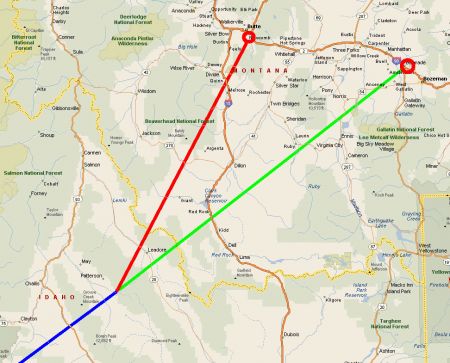The pilot’s original destination was Bozeman, Montana. But the pilot amended his flight plan and diverted to Butte. The pilot did not tell air traffic control why he was diverting. About 25 minutes later, as the aircraft approached for landing at Butte, it went out of control and crashed.
The NTSB is now investigating two things: (1) why the pilot diverted to Butte, especially when he was so close to Bozeman, and (2) why the pilot lost control and crashed so near the runway at Butte.
Some possible explanations for diverting include:
- Low fuel;
- Concerns about weather at the destination;
- Sick passenger;
- Need for a bathroom;

- Mechanical issues;
- Medical issue afflicting the pilot.
Some possible explanations for losing control of an aircraft on approach to landing include:
- Mechanical/structural issues;
- Icing;
- Improper weight and balance (aircraft load not properly distributed);
- Pilot error;
- Medical issue afflicting the pilot.
“Occam’s Razor” suggests that a theory relying on one anomaly to explain an accident sequence is more likely to be correct than one relying on two anomalies. In other words, the simplest answer is usually the best answer. Here, one anomaly that explains both the mysterious diversion to Butte and the loss of control 25 minutes later is a medical issue afflicting the pilot.
A Butte coroner, Lee LaBreche, autopsied the pilot. He found that the 65 year-old did, in fact, have heart disease. He thus noted that "the presence of a pathologic condition of the heart causing this accident cannot be excluded." Nonetheless, LaBreche felt a heart attack was unlikely because the pilot never reported any symptoms to air traffic control. According to Examiner.com:
Federal investigators have said that in [the pilot’s] last recorded communications with air traffic controllers he gave no indication of any problems. LaBreche said that supports the premise that there was no medical emergency.
The coroner’s reasoning is flawed. Pilots have little hesitancy about reporting mechanical problems. However, a pilot would be very reluctant to report to air traffic control that he is having the symptoms of a heart attack. That sort of report will keep a pilot grounded for a long, long time, even if the symptoms ended up being a false alarm. So, while the fact that the pilot reported no problems may support the premise that he had no mechanical issue, it says nothing about whether he had a medical issue. For those who favor Occam’s Razor as an investigatory tool, a heart attack is the most likely cause of this accident.
Related Post: NTSB Reports Show Pilatus Pilot Under Stress
